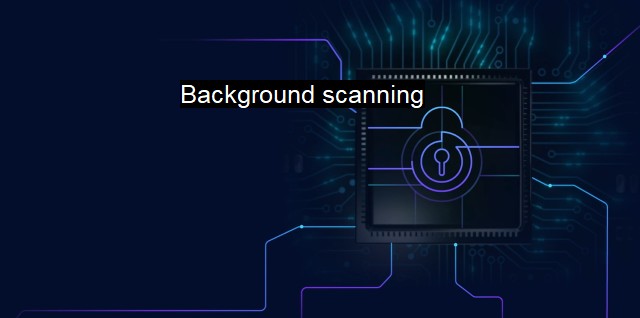What is Background scanning?
The Importance of Background Scanning in Cybersecurity: Detecting and Preventing Hidden Threats
Background Scanning, within the context of cybersecurity and antivirus software applications, denotes one of the most critical tools in protecting an individual's or an organization's digital computing environment against the incessant threats from viruses, malware, Trojans, spyware, and other malicious programs. It's a non-invasive scanning feature designed to examine files, applications, and overall system operations subtly, without disturbing the user and maintaining the computer's performance at normal levels.Background Scanning, also commonly referred to as the "on-access" scanning or real-time scanning, works relentlessly in the background of a device's operating system. As a passive yet vigilant guard, it continuously scans files as they're open, saved, or downloaded, following an approach known as 'scan-as-you-go'. This type of scanning ensures that even when routine full system scans have elapsed due to specific reasons, Your device remains safe as any file that gets accessed undergo automatically scrutinized before running on your device.
The actualization of Background Scanning in an antivirus program is borne out of the conception of extensible security and elevating performance. Traditional antivirus scanning methods, often characterized as active scans, necessitate the consumption of notable resources to effectuate an in-depth exploration. These practices frequently culminate in system slowdown, impacting other applications or activities that are concurrently in progress, thus detrimentally compromising user experience.
In the wake of Background Scanning, the complete examination of the computer's files is done without intervention, thus drastically reducing the risk of slowed performance. Delivering efficiency in a non-intrusive approach, this automated feature is depicted inherently comprehensive, spotting and analyzing threats in real-time, and being far more than merely a convenience, a boosted cybersecurity safeguarding one's device round-the-clock.
Background Scanning is a crucial element of an antivirus application for another pivotal raison d'etre: the uprising interconnectivity around us, coupled with the sophisticated nature of today's cyber threats, make constant vigilance paramount. In this digital age, a legit website visited countless times may be hacked unnoticed, and its downloads or ads could harbor malcode desiring only a click to get activated. Hence, Background Scanning embodies a firewall; by scrutinizing every file that attempts to execute on a device, it obstructs malware or virus outbreak even before it starts.
Though pivotal and resourceful, this tool is not impeccable; it is as robust and efficient as the antivirus software or security suite that empowers its operation. Thus, on the backdrop of evolving threats, today's antivirus solutions are enriched with AI and machine learning mechanisms to discover, prevent, and immunize against novel and unidentified threats, including zero-day exploits.
Phishing and ransomware threats have evolved into unprecedented levels affecting individuals and organizations alike globally; to tackle this, many antivirus and cybersecurity protection packages have integrated web protection features like anti-phishing and anti-ransomware capabilities with Background Scanning, reinforcing the frontlines of digital security.
Besides, to make this feature cheaper on system resources, most antiviruses incorporate a technique termed 'whitelist' or 'trust list', wherein known safe files are not rescanned unless they change, minimizing superfluous operations and freeing system resources for other tasks.
Background Scanning, with its eclectic mixture of versatility, sophistication, and non-intrusiveness, manifests as a pivotal warranty against the continuously evolving sphere of relentless cyber threats. By exercising persisting vigilance and real-time protective coverage, it certifies a minuscule window of susceptibility, guaranteeing the health and robustness of digital computing systems while establishing the groundwork of perpetuating trust amid the expanding vistas of cyberspace.

Background scanning FAQs
What is background scanning?
Background scanning is a cybersecurity feature that continuously searches for and scans files and data on a computer or network in the background, without disrupting the user's normal activities. It is used by antivirus software to identify potential threats and protect against malware and other cybersecurity risks.How does background scanning work?
Background scanning works by using algorithms and heuristics to analyze files and data on a computer or network. It compares the information against a database of known threats, and looks for unusual behavior or patterns that might indicate the presence of malware. The scanning process can be set to run automatically on a regular basis, or triggered by specific events or activities on the computer.Is background scanning necessary?
Yes, background scanning is an important part of any cybersecurity strategy. It helps to identify and eliminate potential threats before they can cause damage or compromise sensitive data. Without background scanning, malware and other cybersecurity risks could go undetected and cause serious harm to a computer or network.Can background scanning slow down my computer?
Background scanning can use up system resources and may cause a temporary slowdown in computer performance. However, most antivirus software is designed to run scans in a way that minimizes the impact on the user's activities. Users can also adjust the settings to prioritize certain tasks or limit the resources used by the scanning process. Overall, the benefits of background scanning generally outweigh any potential performance issues.| | A | | | B | | | C | | | D | | | E | | | F | | | G | | | H | | | I | | | J | | | K | | | L | | | M | |
| | N | | | O | | | P | | | Q | | | R | | | S | | | T | | | U | | | V | | | W | | | X | | | Y | | | Z | |
| | 1 | | | 2 | | | 3 | | | 4 | | | 7 | | | 8 | | |||||||